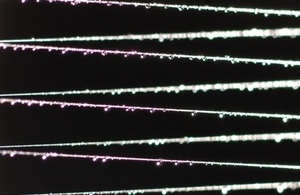Spooky spider science
Spiders’ webs are being used at the Defence Science and Technology Laboratory (Dstl) to study how biological materials could survive.

Spiders web with droplets from an aerosol
Spiders spin their webs around a purpose-built frame, the frames are then placed into a container and an aerosol containing infectious micro-organisms, such as Ebola virus or the Plague bacterium, is sprayed across the frame.
The micro-threads are so fine they do not absorb any of the biological material, so show how the microorganisms may survive or persist naturally in the environment.
Dstl scientists can then change the conditions in the container – temperature, humidity, or light for example – to mimic how such conditions affect the persistence and survival of infectious aerosols in the outside environment.
Dstl’s Dr Steve Lever says the work is helping provide the necessary evidence to prepare for a potential threat:
By increasing our basic understanding of the survival characteristics of threat agents, we can help determine the best response to any biological release – whether accidental or intentional.
Using spiders’ webs isn’t a new method – this technique has been used by defence scientists since the 1960s – but Dstl has created the special frames to draw on its potential, along with the use of a suite of other analytical tools, such as computer modelling and containment drums.
Dstl media enquiries
Email DstlPress@dstl.gov.uk
Press office 01980 950000 option 2